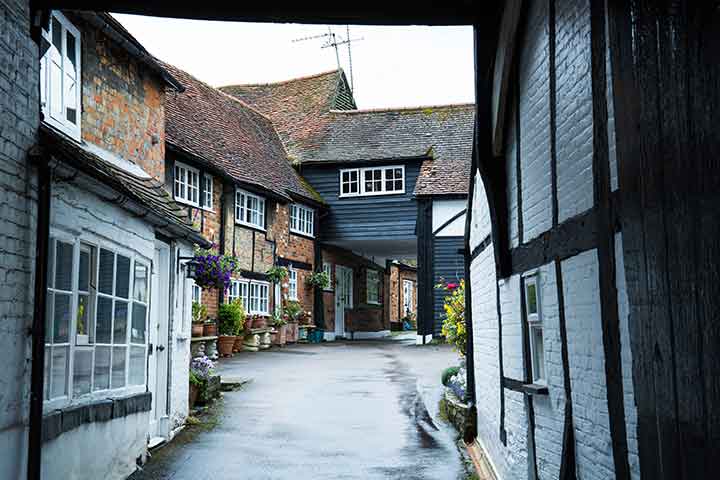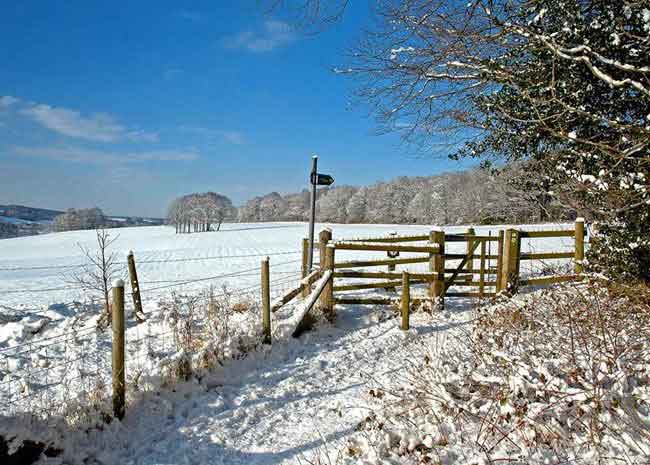Above: Part of the Chiltern Heritage Trail in Old Amersham.
The Chilterns Area of Outstanding Natural Beauty and surrounding area is rich in history.
The Chiltern Society cycle group frequently visits some of the more accessible sites, stopping for a mid-ride break when this is convenient. All the places mentioned below, and many others in the area, can be reached by bike – but probably not in a single day!
Around Amersham
A settlement existed on the present site of the market town of Amersham in Anglo-Saxon times, and the Domesday Book includes an entry under the name of Elmodesham. The town holds a Royal Charter authorising a weekly market as well as an annual fair in September.
Amersham prospered during the 18th century when it became established as a stop for stagecoaches travelling between London and Oxford, or between Reading and Hatfield. Several coaching inns remain in the old town, including The Crown, The Kings Arms and The Saracens Head. The town has also been the location for several commercially successful films, the best known probably being the 1994 romantic comedy, Four Weddings and a Funeral, which featured a number of scenes shot in a suite at The Crown.
Shardeloes Manor, a large 18th century Grade I listed building overlooking a lake created by a dam across the River Misbourne, is situated one mile west of Amersham. The mansion was built for the Tyrwhitt-Drake family, and remained their home until WWII, when it became a maternity hospital; Sir Tim Rice was one of approximately 3,000 children born there. Shardeloes was subsequently saved from demolition thanks to a campaign coordinated by the Amersham Society. It’s now in private ownership but can be seen from the public footpaths across the grounds. The local cricket club has the unusual privilege of having a ground within the estate, with views of the mansion.
The Chilterns have long been known as an area with a reputation for religious dissent, with a strong representation of minority groups including Quakers and, in the 16th century, The Lollards, who believed they should be able to read the bible in English and interpret the texts for themselves. They were condemned by the church for doing so, and in 1521, seven individuals were burnt at the stake near Amersham. A memorial to the Martyrs of Amersham was erected on the hill above the town, near Ruccles Field, adjacent to the site of the executions, and still stands today.
The Quakers, or the society of Friends, originated in the 17th century as a group of dissenting Protestants with no organised clergy. The movement was widespread in the Chilterns, perhaps most famously in the village of Jordans, where a large Meeting House was built in 1688. The magnificent Grade I listed building was severely damaged by fire in 2005, but has been carefully restored and is again open to visitors. The burial ground surrounding the Meeting House includes the graves of William Penn, the founder of Pennsylvania, his two wives Gulielma and Hannah, and nine of his children. Many other early Quakers are also buried there. jordansquakercentre.org
The area north of Henley-on-Thames
The country house called Greenlands is situated on the north bank of the Thames about two miles downstream from Henley. In 1871 it was bought by the descendants of the founder of the newsagent and stationery company W H Smith & Son, and remained their home until 1946. It then became the headquarters of the Administrative Staff College, renamed Henley Management College in 1991. In 2008 a merger with the Business School of Reading University created the new Henley Business School. The buildings are clearly visible from the towpath on the south bank of the river, which is easily accessible by bike.
Stoke Row is the site of a well with an unusual history. During the 19th century, Edward Reade, who was from a wealthy family in Ipsden, spent many years working in India. He was involved in a project to sink a well for a village in Benares, where he told the local Maharajah that the area of the Chilterns where his family lived also sometimes suffered from drought conditions. In recognition of the work carried out in India by Reade, the Maharajah provided funds for a well to be sunk in the village of Stoke Row, together with a cottage for the well-keeper and a cherry orchard, which provided a source of income to pay the upkeep of the well. It was opened in 1864 and remained in use for over 70 years. The canopy of the well on top of the cast iron machinery is decorated with a gilded elephant, which was repainted in 2008. It’s visible from the main street and costs nothing to visit (maharajahswell.org.uk)

John Hampden
The Hampden family lived in Great Hampden, near Prestwood. Their home, Hampden House, is a Grade I listed building of architectural and historical significance. It remains a private house with no public access but can be seen from the Chiltern Way which passes nearby.
Adjacent to the house is the church of St Mary Magdalene (pictured above), which contains Hampden’s grave, with a monument by Sir Henry Cheere. John Hampden was a parliamentarian who opposed the ship money tax imposed by Charles I and fought in the Civil War. According to legend, he was mortally wounded by carbine balls penetrating his shoulder at the battle of Chalgrove Field. An examination of his skeleton during the 19th century showed severe damage to his right hand, but no other major injuries. It’s now thought likely that the damage was caused by the discharge of his pistol, and he probably died of gangrene, septicaemia and tetanus infection in his wounded hand. A monument commemorating John Hampden and the ship money tax was erected in the 19th century between Great Hampden and Prestwood. Now cared for by the Chiltern Society, it’s easy to cycle to the site and enjoy the fine views across the Vale of Aylesbury.

Around Wendover
A market town, in existence before the Norman Conquest, Wendover grew up round the point where the main route from London to Aylesbury crosses the road running along the foot of the Chilterns. The red brick clock tower, with it’s tall spire, built in 1842, stands at the crossroads in the centre of the town. During the 18th century, Wendover, like Amersham, developed as a stop for stagecoaches and several coaching inns remain in the High Street, including The Red Lion.
The Grand Union Canal (pictured above) passes through the Chilterns between Berkhamsted and Tring. It was created in 1929 by the merger of several existing canals, including the Grand Junction Canal. The construction work probably created similar levels of opposition and objections from the local population to those engendered by the M40 motorway, or more recently, the HS2 rail link. The Grand Union Canal is now a popular tourist attraction, with the towpath being open to both walkers and cyclists. A small branch canal, the Wendover Arm, opened in 1799, connecting Wendover to the Grand Union Canal at Bulbourne. Over the years, problems with water leakage affected the Wendover Arm and much of the central section was drained in 1904. A long-term project to restore the full length of the canal began in 1989 and is still making slow but steady progress. Meanwhile, the towpath along the canal from Wendover and through Halton provides an attractive cycling and walking route.
This selection of historic places provides a few ideas to inspire some cycle routes. There are gateway towns where you can access the Chilterns Cycleway and see some of the historical highlights mentioned. The Chilterns Cycleway official guide can be purchased on our website.
The Chilterns National Landscapes also have some cycling suggestions on a helpful map.





